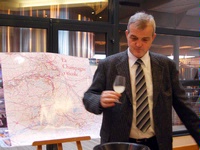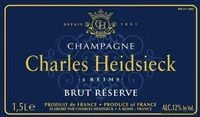It is well understood that a vintage statement on a bottle of Champagne is an indication of superior quality. The Champagne region of France, about an hour from Paris by train or car, is so far north that ripening patterns from year to year can be tricky, complicating life for those who would wish every year to be a vintage year in Champagne.
Sadly, it isn’t. When nature hasn’t been kind, most reputable Champagne houses abstain from declaring a vintage. But even then, all is not lost. Non-vintage, or what some would call multi-vintage Champagne, is the bread and butter of the industry. And, contrary to what a reasonable person might conclude, non-vintage Champagne hardly means bad Champagne.
 The clever Champenoise have devised a system that ensures there will always be outstanding bubbly to pop open for the holidays, no matter how lean the harvest might have been in some years. The reason is simple: Top Champagne houses hold back a portion of their production from each of the good vintages. These reserve wines are blended with the best wines from the so-called “off” vintages to achieve consistency of quality and to craft a house style.
The clever Champenoise have devised a system that ensures there will always be outstanding bubbly to pop open for the holidays, no matter how lean the harvest might have been in some years. The reason is simple: Top Champagne houses hold back a portion of their production from each of the good vintages. These reserve wines are blended with the best wines from the so-called “off” vintages to achieve consistency of quality and to craft a house style.
A Champagne house lives and dies by its reserve stocks, largely because non-vintage Champagne represents the bulk of production. The storied Piper-Heidsieck Champagne house offers a good example of the importance of reserve stocks. Over a period of a couple of decades in the 1980s and early 1990s, Piper allowed its reserve stocks to dwindle. The quality of Piper’s non-vintage brut suffered as a result and the reputation of the house cratered.
Winemaker Regis Camus joined the winery in 1994 and was elevated to Chef de Cave in 1998, when he embarked upon an ambitious plan to restore the tarnished Piper-Heidsieck reputation. To accomplish his goal and speed the return of Piper to elite status in the world of Champagne, Camus refused to produce vintage Champagne in some very good years. It raised eyebrows, but it worked. Its reserve stock replenished, today Piper-Heidsieck’s non-vintage brut is among the finest in Champagne.
Over the past six months I’ve had an opportunity to taste a number of top non-vintage Champagnes at two major international wine competitions: Critics Challenge in June and Sommelier Challenge in September. Champagne, in particular non-vintage brut, shined at both.
As you choose bubbly for the holidays, you would do well to consider any of these six award-winning Champagnes:
 Charles Heidsieck Brut Reserve ($65) – This beautiful multi-vintage Champagne took a platinum medal at the Critics Challenge. It is rich and creamy, with notes of brioche and a remarkably long finish.
Charles Heidsieck Brut Reserve ($65) – This beautiful multi-vintage Champagne took a platinum medal at the Critics Challenge. It is rich and creamy, with notes of brioche and a remarkably long finish.
Charles Heidsieck Rose Reserve ($80) – Charles Heidsieck is the kissing cousin of Piper-Heidsieck. It was made famous to some extent by its incredibly rare tetes-de-cuvee “Champagne Charlie.” The Rose Reserve may not be as rare, but you won’t be disappointed in this powerful, inviting bubbly that can be matched with savory cuisine and hold its own. Also a platinum medal-winner at Critics Challenge.
Moet & Chandon Brut Imperial ($42) – This workhorse non-vintage brut was awarded a gold medal by judges at the Sommelier Challenge in September. Sommelier Challenge is a unique wine competition in which all of the judges who evaluate the entries are certified sommeliers. This beautifully balanced multi-vintage brut Champagne is one of the finest non-vintage bruts I’ve encountered from Moet.
Mumm Cordon Rouge ($49) – Mumm underwent a renaissance in the cellar that was very similar to that experienced at Piper-Heidsieck. Under the guidance of Chef de Cave Dominique Demarville, who has since moved on to become Cellar Master at Veuve Clicquot, Mumm stormed back to prominence in the late 1990s. Its flagship wine, the rich, toasty non-vintage Cordon Rouge, is now as good as it ever was, and it won a gold medal at the Critics Challenge earlier this year.
Perrier-Jouet Grand Brut ($55) – This brilliant Champagne house in Epernay is a model of consistency, but that said I do believe the Grand Brut is better now than it’s ever been. This one took a gold medal at the Critics Challenge (all of the judges are renowned wine journalists). It is firmly structured and has the potential to evolve beautifully with additional age, though it is meant to be consumed upon release.
Piper-Heidsieck Brut ($50) – This lovely wine won a platinum medal at the Critics Challenge and in my humble opinion is the finest value in non-vintage brut Champagne today. I recently purchased several magnums for less than $70 apiece, which works out to about $35 a bottle. If you can find a similar deal where you shop for wine, my advice would be to load up the cart!
8
